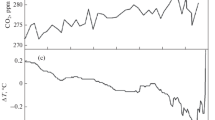Abstract
Paleoclimatic studies of the Medieval Solar Maximum (c. A.D. 1100–1250, corresponding with the span of the Medieval Warm Epoch) may prove useful because it provides a better analog to the present solar forcing than the intervening era. The Medieval Solar Activity Maximum caused the cosmogenic isotope production minimum during the 12th and 13th Centuries A.D. reflected by Δ14C and 10Be records stored in natural archives. These records suggest solar activity has returned to Medieval Solar Maximum highs after a prolonged period of reduced solar activity. Climate forcing by increased solar activity may explain some of this century’s temperature rise without assuming unacceptably high climate sensitivity. By analogy with the Medieval Solar Activity Maximum, the contemporary solar activity maximum may be projected to last for 150 years. The maximum temperature increase forced by increased solar activity stays well below the predicted doubled atmospheric CO2 greenhouse forcing.
Access this chapter
Tax calculation will be finalised at checkout
Purchases are for personal use only
Preview
Unable to display preview. Download preview PDF.
Similar content being viewed by others
References
Beer, J., Raisbeck, G. M., and Yiou, F.: 1991, Time Variations of 10Be and Solar Activity’, in Sonett, C. P., Giampapa, M. S., and Matthews, M. S. (eds.), The Sun in Time, University of Arizona Press, Tucson, 343 pp.
Bradley, R. S.: 1985, Quarternary Paleoclimatology: Methods of Paleoclimatic Reconstruction, Allen and Unwin, Boston, p. 472.
Damon, P. E. and Jirikowic, J. L.: 1992a, ‘Radiocarbon Evidence for Low Frequency Solar Oscillations’, in Povinec, P. (ed.), Rare Nuclear Decay Processes: Proceedings of the 14th European Physics Society Meeting, Bratislava, October 1990, 457 pp.
Damon, P. E. and Jirikowic, J. L.: 1992b, ‘Solar Forcing of Global Climate Change?’, In Taylor, R. E., Long, A., and Kra, R. (eds.), Four Decades of Radiocarbon, Springer-Verlag, New York, 117 pp.
Damon, P. E. and Sonett, C. P.: 1991, ‘Solar and Terrestrial Components of the Atmospheric 14C Variation Spectrum’, in Sonett, C. P., Giampapa, M. S., and Matthews, M. S. (eds.), The Sun in Time, University of Arizona press, Tucson, 360 pp.
Eddy, J. A.: 1976, The Maunder Minimum’, Science 192, 1189–1202.
Eddy, J. A.: 1977, ‘Climate and the Changing Sun’, Climatic Change 1, 173.
Grove, J. M.: 1991, The Little Ice Age, Routledge, London, p. 498.
Hansen, J. E. and Lacis, A. A.: 1990, ‘Sun and Dust versus Greenhouse Gases: As Assessment of Their Relative Roles in Global Climate Change’, Nature 346, 713.
Hansen, J. E. and Lebedeff, S.: 1988, ‘Global Surface Air Surface Temperatures Update through 1987’, Geophys. Res. Let. 15, 323.
Hastenrath, S. and Kruss, P. D.: 1992, ‘Greenhouse Indicators in Kenya’, Science 355, 503.
Hood, L. L. and Jirikowic, J. L.: 1990, ‘Recurring Variations of a Probable Solar Origin on the Atmospheric Δ14C Record’, Geophys. Res. Let. 17, 85.
Jones, P. D., Wigley, T. M. L., and Wright, P. B.: 1986, ‘Global Temperature Variation between 1862 and 1984’, Nature 322, 430.
Lamb, H. H.: 1965, ‘The Early Medieval Warm Epoch and Its Sequel’, Paleogeog., Paleoclim., Paleoecol. 1, 13.
Lean, J., Skumanich, A., White, O.: 1992, ‘Estimating the Sun’s Radiative Output during the Maunder Minimum’, Geophys. Res. Let. 19, 1591.
O’Brien, K., de al Zerda Lerner, A., Shea, M. A., and Smart, D. F.: 1991, ‘The Production of Cosmogenic Isotopes in the Earth’s Atmosphere and Their Inventories’, in Sonett, C. P., Giampapa, M. S., and Matthews, M. S. (eds.), The Sun in Time, Tucson, University of Arizona Press, 317 pp.
Raisbeck, G. M., Yiou, F., Jouzel, J., and Petit, J. R.: 1990, ‘1Be and δ2H in Polar Ice Cores as a Probe of the Solar Variability’s Influence on Climate’, Phil. Trans. R. Soc. Lond. A330, 463.
Reid, G. C. and Gage, K. S.: 1988, ‘The Climatic Impact of Secular Variations in Solar Irradiance’, in Stephenson, F. R. and Wolfdale, A. W. (eds.), Secular, Solar, and Geomagnetic Variations in the Last 10,000 Years, Kluwer Academic Press, Dordrecht, 225 pp.
Rothlisberger, F.: 1986, 10000 Jahre Gletschergeschichte der Erde, Aarau, Verlag Sauerlander, p. 416.
Schatten, K. H. and Arking, A. (eds.): 1990, Climate Impact of Solar Variability, NASA Conference Publication 3086, p. 376.
Stuiver M. and Pearson G. W. 1986 ‘High Precision Calibration of the Radiocarbon Time Scale A.D. 1950–500 BC in Stuiver M. and Kra R. S. eds. Radiocarbon 282B 805
Stuiver, M. and Quay, P. D.: 1980, ‘Changes in Atmospheric Carbon-14 Attributed to a Variable Sun’, Science 207, 11.
Wigley, T. M. L.: 1988, ‘The Climate of the Past 10,000 Years and the Role of the Sun’, in Stephenson, F. R. and Wolfdale, A. W. (eds.), Secular, Solar, and Geomagnetic Variations in the Last 10,000 Years, Kluwer Academic Press, Dordrecht, 209 pp.
Wigley, T. M. L. and Kelly, P. M.: 1990, ‘Holocene Climate Change, 14C Wiggles and Variations in Solar Irradiance’, Phil. Trans. R. Soc. of Lond. A330, 547.
Wigley, T. M. L. and Raper, S. C. B.: 1987, ‘Thermal Expansion of Sea Water Associated with Global Warming’, Nature 330, 127.
Willson, R. C. and Hudson, H. S.: 1988, ‘Solar Luminosity Variations in the Solar Cycle’, Nature 332, 810.
Author information
Authors and Affiliations
Editor information
Editors and Affiliations
Rights and permissions
Copyright information
© 1994 Springer Science+Business Media Dordrecht
About this chapter
Cite this chapter
Jirikowic, J.L., Damon, P.E. (1994). The Medieval Solar Activity Maximum. In: Hughes, M.K., Diaz, H.F. (eds) The Medieval Warm Period. Springer, Dordrecht. https://doi.org/10.1007/978-94-011-1186-7_12
Download citation
DOI: https://doi.org/10.1007/978-94-011-1186-7_12
Publisher Name: Springer, Dordrecht
Print ISBN: 978-94-010-4518-6
Online ISBN: 978-94-011-1186-7
eBook Packages: Springer Book Archive




